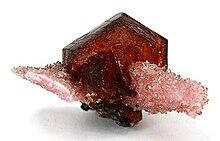| Shigaite | |
|---|---|
 Reddish-brown shigaite crystal (2 cm across) with pink rhodochrosite from South Africa Reddish-brown shigaite crystal (2 cm across) with pink rhodochrosite from South Africa | |
| General | |
| Category | Sulfate mineral |
| Formula (repeating unit) | NaAl3(Mn)6(SO4)2(OH)18·12H2O |
| IMA symbol | Sga |
| Strunz classification | 7.DD.35 |
| Dana classification | 31.1.2.1 |
| Crystal system | Trigonal |
| Crystal class | Rhombohedral (3) H-M symbol: (3) |
| Space group | R3 |
| Unit cell | a = 9.51 Å, c = 32.83 Å, Z = 3 |
| Identification | |
| Color | Yellow, burnt orange, brown, black |
| Twinning | On {0001} |
| Cleavage | Perfect on {0001} |
| Tenacity | Moderately flexible |
| Mohs scale hardness | 2 |
| Luster | Vitreous to dull |
| Streak | Very pale yellow to white |
| Diaphaneity | Transparent |
| Specific gravity | 2.32 |
| Optical properties | Uniaxial (−) |
| Refractive index | n = 1.546 |
| Pleochroism | Distinct; O = yellow; E = very pale yellow |
| Ultraviolet fluorescence | Non-fluorescent |
Shigaite is a mineral with formula NaAl3(Mn)6(SO4)2(OH)18·12H2O that typically occurs as small, hexagonal crystals or thin coatings. It is named for Shiga Prefecture, Japan, where it was discovered in 1985. The formula was significantly revised in 1996, identifying sodium as a previously unknown constituent.
Description

Shigaite occurs as hexagonal tabular crystals up to 2 cm (0.79 in) in size or as thin films and coatings. The mineral can be yellow, burnt orange, brown or black in color. Shigaite occurs in metamorphosed deposits of manganese ore and is the Mn analogue of motukoreaite.
Structure
Shigaite consists of oxycation sheets of intercalated with oxyanion sheets of . Linkage between the sheets and within the oxyanion sheet results largely through hydrogen bonding.
History
Shigaite was discovered in 1985 in the Ioi Mine, Shiga Prefecture, Japan. The original study, published in the journal Neues Jahrbuch für Mineralogie, Monatshefte, identified the formula as Al4Mn7(SO4)2(OH)22·8H2O. The formula was significantly revised in 1996 using a sample from the N'Chwaning Mine, South Africa. Sodium, discovered to be a component of shigaite, was not identified in the original study. However, an unidentified volatile had been noted that presumably was a sodium-containing complex.
Distribution
As of 2012, shigaite is known from the following sites:
- Iron Monarch open cut, South Australia, Australia
- Poudrette quarry, Quebec, Canada
- Ioi mine, Shiga Prefecture, Japan
- Wessels Mine, Northern Cape Province, South Africa
- N'Chwaning Mine, Northern Cape Province, South Africa
- Homer Mine, Michigan, United States
- Bengal Mine, Michigan, United States
The type material is housed in the National Museum of Natural History in Washington, D.C. as sample 122089.
Association
Shigaite has been found associated with the following minerals:
|
Ioi mine, Japan
|
Wessels Mine, South Africa
|
Iron Monarch, South Australia
|
Notes
- Some sources incorrectly list it as the Loi Mine, presumably because of a mistaken reading of uppercase "i" as lowercase "L".
References
- ^ Nickel, Ernest H. "IMA/CNMNC List of Mineral Names" (PDF). Materials Data, Inc. Retrieved May 6, 2012.
- Warr, L.N. (2021). "IMA–CNMNC approved mineral symbols". Mineralogical Magazine. 85 (3): 291–320. Bibcode:2021MinM...85..291W. doi:10.1180/mgm.2021.43. S2CID 235729616.
- ^ "Shigaite". Mindat. Retrieved April 20, 2012.
- ^ "Shigaite Mineral Data". Webmineral. Retrieved May 20, 2012.
- ^ "Shigaite" (PDF). Handbook of Mineralogy. Mineral Data Publishing. Retrieved April 20, 2012.
- ^ Cooper, p. 91.
- ^ Hawthorne, Frank C.; et al. (November–December 1986). "New Mineral Names" (PDF). American Mineralogist. 71 (11 & 12): 1546. Retrieved May 17, 2012.
- Cooper, p. 96.
Bibliography
- Cooper, Mark A.; Hawthorne, Frank C. (February 1996). "The crystal structure of shigaite, (AlMn (super 2+)2 (OH)6)3 (SO4)2 Na(H2O)6 {H2O}6, hydrotalcite-group mineral" (PDF). The Canadian Mineralogist. 34 (1): 91–97. ISSN 0008-4476. Retrieved May 23, 2012.
Further reading
- Pring, A.; Slade, P. G.; Birch, W. D. (September 1992). "Shigaite from Iron Monarch, South Australia" (PDF). Mineralogical Magazine. 56 (384): 417–419. Bibcode:1992MinM...56..417P. doi:10.1180/minmag.1992.056.384.15. S2CID 140697083. Retrieved April 20, 2012.